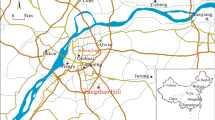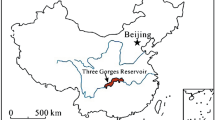Abstract
The landslide mechanism and failure mode of the gently sloping Piedmont region are analyzed in Fangshan and Zhutoushan hills in the Nanjing area of Jiangsu Province, China. These hills are underlain by volcanic rocks and have a distinctive stratigraphic structure composed of fill or clay at the surface, coarse-grained soil or fully weathered rock in the middle, and highly or moderately weathered rock at the bottom. Landslides occurred during or after heavy rainfall, and the monitored displacements of the slope surface indicated that sliding had not stopped after a long period of continuous rainfall. Through monitoring of groundwater and simulation, we found that the low-permeability highly weathered rock can restrict the activity of the lower aquifer, resulting in a rapid rise of pore pressure and formation of confined water in response to rainfall, which can lead to slope failure. We discuss the mechanism and avulsed–drifted failure mode of the landslides considering seepage deformation and pressure balance. Finally, we propose appropriate control measures for these landslides. The results of this paper will contribute to prevention of similar landslide geological hazards.



















Similar content being viewed by others
References
Bai SB, Wang J, Thiebes B, Cheng C, Yang Y (2013) Analysis of the relationship of landslide occurrence with rainfall: a case study of Wudu County China. Arab J Geosci 7(4):1277–1285. https://doi.org/10.1007/s12517-013-0939-9
Eab KH, Takhashi A, Likitlersuang S (2014) Centrifuge modelling of root-reinforced soil slope subjected to rainfall infiltration. Géotech Lett 4(3):211–216. https://doi.org/10.1680/geolett.14.00029
Eab KH, Likitlersuang S, Takahashi A (2015) Laboratory and modelling investigation of root-reinforced system for slope stabilisation. Soils Found 55(5):1270–1281. https://doi.org/10.1016/j.sandf.2015.09.025
Finlay PJ, Fell R, Maguire PK (1997) The relationship between the probability of landslide occurrence and rainfall. Can Geotech J 34(6):811–824. https://doi.org/10.1139/t97-047
He K, Liu B, Hu XW (2021) Preliminary reports of a catastrophic landslide occurred on August 21 2020 in Hanyuan County Sichuan Province China. Landslides 18(1):503–507. https://doi.org/10.1007/s10346-020-01566-5
Hu XL, Zhang M, Sun MJ, Huang KX, Song YJ (2013) Deformation characteristics and failure mode of the Zhujiadian landslide in the Three Gorges Reservoir China. Bull Eng Geol Environ 74(1):1–12. https://doi.org/10.1007/s10064-013-0552-x
Huang R (2007) Large scale landslides and slide mechanism in China since the 20th century. Chin J Rock Mech Eng 26(3):433–454
Huang D, Zhang XJ, Gu DM (2018) Failure pattern and evolution mechanism of locking section in rock slope with three-section landslide mode. Chin J Geotech Eng 40(9):1601–1609. https://doi.org/10.11779/CJGE201809005
Jian WX, Wang ZJ, Yin KL (2009) Mechanism of the Anlesi landslide in the Three Gorges Reservoir China. Eng Geol 108(1–2):86–95. https://doi.org/10.1016/j.enggeo.2009.06.017
Jiang QH, Wei W, Xie N, Zhou CB (2015) Stability analysis and treatment of a reservoir landslide under impounding conditions: a case study. Environ Earth Sci 75(1):1–12. https://doi.org/10.1007/s12665-015-4790-z
Jiao JJ, Wang X-S, Nandy S (2005) Confined groundwater zone and slope instability in weathered igneous rocks in Hong Kong. Eng Geol 80(1–2):71–92. https://doi.org/10.1016/j.enggeo.2005.04.002
Lee YS, Cheuk CY, Bolton MD (2008) Instability caused by a seepage impediment in layered fill slopes. Can Geotech J 45(10):1410–1425. https://doi.org/10.1139/T08-067
Leknoi U, Likitlersuang S (2020) Good practice and lesson learned in promoting vetiver as solution for slope stabilisation and erosion control in Thailand. Land Use Policy 99(1–2):105008. https://doi.org/10.1016/j.landusepol.2020.105008
Likitlersuang S, Takahashi A, Eab KH (2017) Modeling of root-reinforced soil slope under rainfall condition. Eng J 21(3):123–132. https://doi.org/10.4186/ej.2017.21.3.123
Lo HC, Hsu SM, Chi SY, Ku CY (2010) Coupled Stability Analyses of Rainfall Induced Landslide: A Case Study in Taiwan Piedmont Area. Geotechnical Special Publication. https://doi.org/10.1061/41105(378)1
National Bureau of Statistics (2018) China Statistical Yearbook. China Statistics Press
Nguyen TS, Likitlersuang S, Ohtsu H, Kitaoka T (2017) Influence of the spatial variability of shear strength parameters on rainfall induced landslides: a case study of sandstone slope in Japan. Arab J Geosci 10(16):1–12. https://doi.org/10.1007/s12517-017-3158-y
Nguyen TS, Likitlersuang S, Jotisankasa A (2020) Stability analysis of vegetated residual soil slope in Thailand under rainfall conditions. Environ Geotech 7(5):338–349. https://doi.org/10.1680/jenge.17.00025
Pánek T, Hartvich F, Jankovská V, Klimeš J, Tábořík P, Bubík M, Smolková V, Hradecký J (2014) Large Late Pleistocene landslides from the marginal slope of the Flysch Carpathians. Landslides 11(6):981–992. https://doi.org/10.1007/s10346-013-0463-8
Rosone M, Ziccarelli M, Ferrari A, Farulla CA (2018) On the reactivation of a large landslide induced by rainfall in highly fissured clays. Eng Geol 235:20–38. https://doi.org/10.1016/j.enggeo.2018.01.016
Su LJ, Xu XQ, Geng XY, Liang SQ (2017) An integrated geophysical approach for investigating hydro-geological characteristics of a debris landslide in the Wenchuan earthquake area. Eng Geol 219:52–63. https://doi.org/10.1016/j.enggeo.2016.11.020
Tang HM, Li CD, Hu XL, Wang LQ, Criss R, Su AJ, Wu YP, Xiong CR (2014) Deformation response of the Huangtupo landslide to rainfall and the changing levels of the Three Gorges Reservoir. Bull Eng Geol Environ 74(3):933–942. https://doi.org/10.1007/s10064-014-0671-z
Tokashiki N, Aydan Ö (2010) Kita-Uebaru natural rock slope failure and its back analysis. Environ Earth Sci 62(1):25–31. https://doi.org/10.1007/s12665-010-0492-8
Yan ZL, Wang JJ, Chai HJ (2010) Influence of water level fluctuation on phreatic line in silty soil model slope. Eng Geol 113(1–4):90–98. https://doi.org/10.1016/j.enggeo.2010.02.004
Yan CH, Xu BT, Wu CY, Tan JZ, Xu CH, Guo SL, Liu Y (2019a) The stratigraphic structure and stability analysis in gentle slopes of Piedmontat Ningzhen area. J Eng Geol 27(1):48–54. https://doi.org/10.13544/j.cnki.jeg.2019-007
Yan XY, Xu BT, Zhang LP, Wang W, Yan CH (2019b) Mechanism analysis of a landslide in highly weathered volcanic rocks of Niushoushan Hill in Nanjing. Environ Earth Sci 78(24):1–25. https://doi.org/10.1007/s12665-019-8705-2
Yan XY, Yan CH, Tan JZ, Wu CY, Guo SL, Xu CH, Wang ZX, Shi W (2020) Analysis on the reactivation mechanism of a piedmont gentle slope landslide in Pukou district Nanjing. Geol Rev 66(6):1626–1636. https://doi.org/10.16509/j.georeview.2020.06.014
Yu LC, Yan CH, Guo SL, Tan JZ, Xu CH, Liu Y, Huang L (2020) Analysis of sliding mechanism of Youzi Mountain affected by temporary confined water in Nanjing. Hydrogeol Eng Geol 47(1):133–141. https://doi.org/10.16030/j.cnki.issn.1000-3665.201901068
Zhang J, Huang HW, Zhang LM, Zhu HH, Shi B (2014) Probabilistic prediction of rainfall-induced slope failure using a mechanics-based model. Eng Geol 168:129–140. https://doi.org/10.1016/j.enggeo.2013.11.005
Zhang JW, Zou Y, Li YL (2016a) Failure mechanism and stability analysis of big multi-layer deposit. Chin J Rock Mech Eng 35(12):2479–2489. https://doi.org/10.13722/j.cnki.jrme.2016.0536
Zhang S, Xu Q, Hu ZM (2016b) Effects of rainwater softening on red mudstone of deep-seated landslide Southwest China. Eng Geol 204:1–13. https://doi.org/10.1016/j.enggeo.2016.01.013
Zhang SL, Zhu ZH, Qi SC, Hu YX, Du Q, Zhou JW (2018) Deformation process and mechanism analyses for a planar sliding in the Mayanpo massive bedding rock slope at the Xiangjiaba Hydropower Station. Landslides 15(10):2061–2073. https://doi.org/10.1007/s10346-018-1041-x
Acknowledgements
Fieldwork was supported by the 1st geological brigade of Jiangsu geology and mining exploration Bureau and Nanjing Metro Group Co., Ltd. The authors acknowledge Chenghua Xu, Baotian Liu, and Wei Shi for on-site scheduling and graduate students including Chengliang Li, Zhuangzhuang Hou, Chao Li, Conghui Dong, and Xiao Zhang for undertaking the field survey.
Funding
This study was supported by the Natural Science Foundation of Jiangsu Province, China (grant number BE2019705), and the Department of Land of Jiangsu Province, China (Grant No. 2017-KY-01).
Author information
Authors and Affiliations
Contributions
Writing—original draft preparation: Liangchen Yu, Changhong Yan, and Shulan Guo; writing—review and editing: Liangchen Yu; investigation: Jingzhong Tan; data collection and analysis: Jingzhong Tan, Jianqiang Guo, and Zhihui Lou; methodology: Liangchen Yu and Jiajia Wan.
Corresponding author
Ethics declarations
Conflict of interest
The authors declare no competing interests.
Supplementary Information
Below is the link to the electronic supplementary material.
Rights and permissions
About this article
Cite this article
Yu, L., Yan, C., Guo, S. et al. Analysis of the mechanism and failure mode of landslides subjected to transient seepage in a Piedmont region of Nanjing area . Bull Eng Geol Environ 80, 7441–7456 (2021). https://doi.org/10.1007/s10064-021-02401-4
Received:
Accepted:
Published:
Issue Date:
DOI: https://doi.org/10.1007/s10064-021-02401-4




